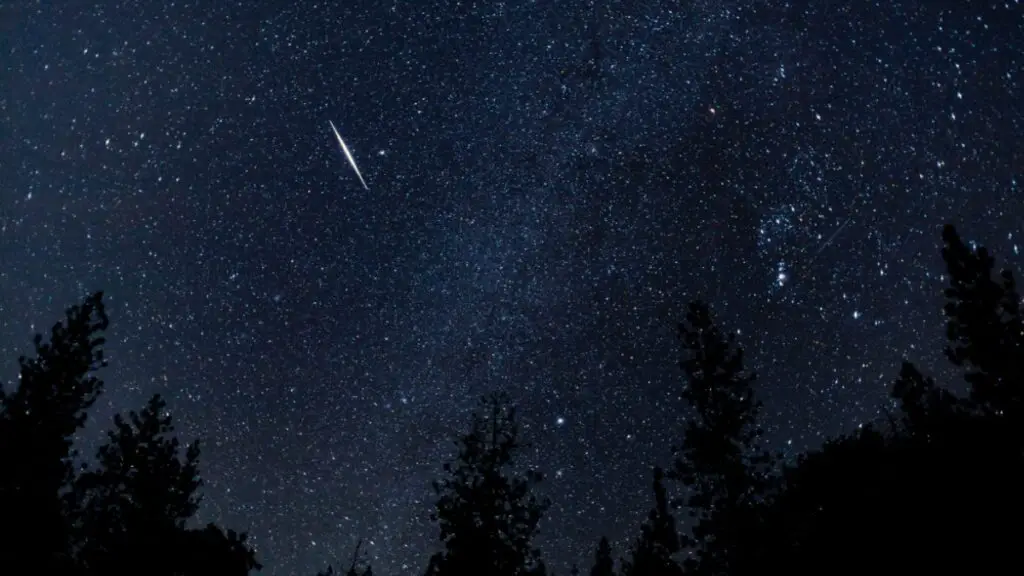Throughout the year, there are many meteor showers that all have distinct qualities and might be more or less simple to identify.
During October, it’s time for the Orionids, one of the best-known meteor showers and also the most consistent. This is also a fantastic chance to step outdoors, examine them personally, and find out what makes them so distinctive.
Shooting stars aren’t truly stars but are created by meteoroids. These are simply rocks moving in space. They might be comparable in size to little pebbles and sand or, on rare occasions, larger things.
As our Earth goes through its orbit around the Sun, it may stumble across these objects by coincidence. There is a lot of this stuff hitting Earth: around 48 tons every day.
As the particles penetrate our atmosphere, they become meteors. The Orionids have an average speed of roughly 61 km/s. The contact with our atmosphere leads them to burn up at high altitudes, causing dazzling streaks in the sky visible for a brief period.
Where are they from?
Meteor showers, however, are not random encounters with meteoroids. Earth occasionally passes through heavier areas of space debris left behind by comets as they go around the Sun.
Comets are filthy snowballs consisting of loose debris that is kept together by frozen gases. When the Earth hits comet debris, meteors may shoot over the sky, putting on a stunning spectacle.
Each meteor shower is tied to a unique comet. The Orionids are of significance, not because there are many meteors, but because they are tied to Halley’s comet. This comet was the first to be classified as periodic — those having orbital periods around the Sun of fewer than 200 years.
Halley completes an orbit every 75 years. You may have missed it when it was near us in 1986, but you can still trace its route through the Orionids.
When Halley approaches near to the Sun, its ice converts to gas, leaving behind a path of loose debris. As Earth travels through here, we witness the Orionid meteor shower.
Meteor showers are simple to enjoy since no technical equipment is needed. But we must cultivate patience and pray for favorable weather. Here are are few recommendations to guarantee your skywatching is successful.
Timing
Make sure you choose the proper time. There are at least a dozen meteor showers throughout the year worth catching. They are named after constellations, indicating from which direction the meteors reach our atmosphere.
If you observe the streaks across a night, they will all apparently radiate from one exact place in the sky (the radiant). For the Orionids that lie in the constellation of Orion, just at the upper left of its shoulder, which is marked by the star Betelgeuse. When you’ve settled on a date, the most hopeful time of night is generally the second half.
The Orionids peak yearly around mid-October. This year’s will occur in the hours after midnight on Sunday, Oct. 22, when the greatest meteor rates are forecast, according to the American Meteor Society.
For the Orionids, you may view an average of 40-70 meteors every hour. If you miss the peak, you will still be able to capture them, you simply won’t see as many.
Location
Light is your adversary. Even if the moon isn’t shining, you need to avoid bright lighting. Find an area that is not directly lit, yet where you feel protected.
You can operate with light pollution in general if it is not too widespread. But the darker the sky gets, the higher the odds of witnessing meteors.
WATCH: NASA scientists announce first near-Earth asteroid sample returned to U.S.
Furthermore, a decent view of the sky is essential. That does not only mean staring towards the radiant, as meteors will streak over the whole sky.
Make sure you can see as much sky as possible. It could also be worth taking a deck chair to recline back comfortably.
Patience
To properly enjoy the blackness of the sky and identify even the fainter meteors, you have to ensure your eyes are acclimated to dark circumstances. This takes 20 to 30 minutes and cannot be hastened.
Stepping into your garden for a short peek doesn’t work. You should bundle yourself warm and carry something hot to drink with you to keep you going.
Remember that you may damage your eyes’ adaptation to the dark by switching on a strong white light source. If you require illumination, cover your flashlight with a red filter. You will be astonished how much you can really see at night by allowing your eyes time to adjust.
The rates that are given for meteor showers (40-70 meteors per hour for the Orionids) are averages. They also refer to the darkest possible sky and presume the radiant is immediately over your head.
Skywatching
Meteor viewing is a fantastic sport for everyone and does not need specific equipment. It engages you with the cosmos and forces you to step out of your daily routine and calm down.
The Orionids provide a rare chance to interact with the sky. So get out there and investigate.









